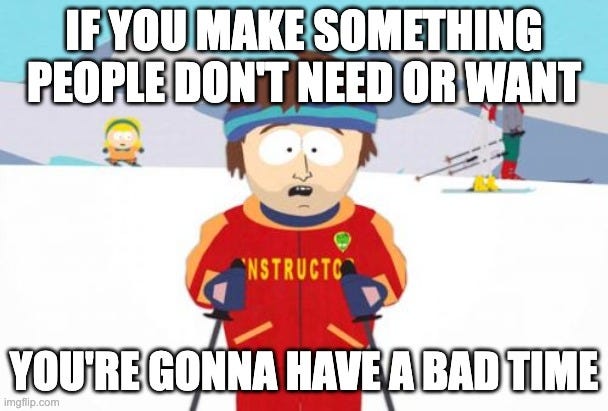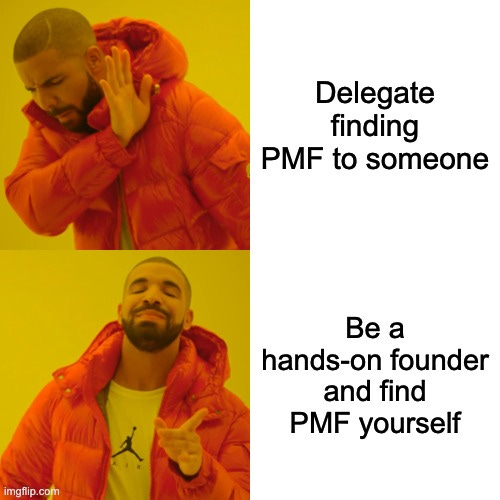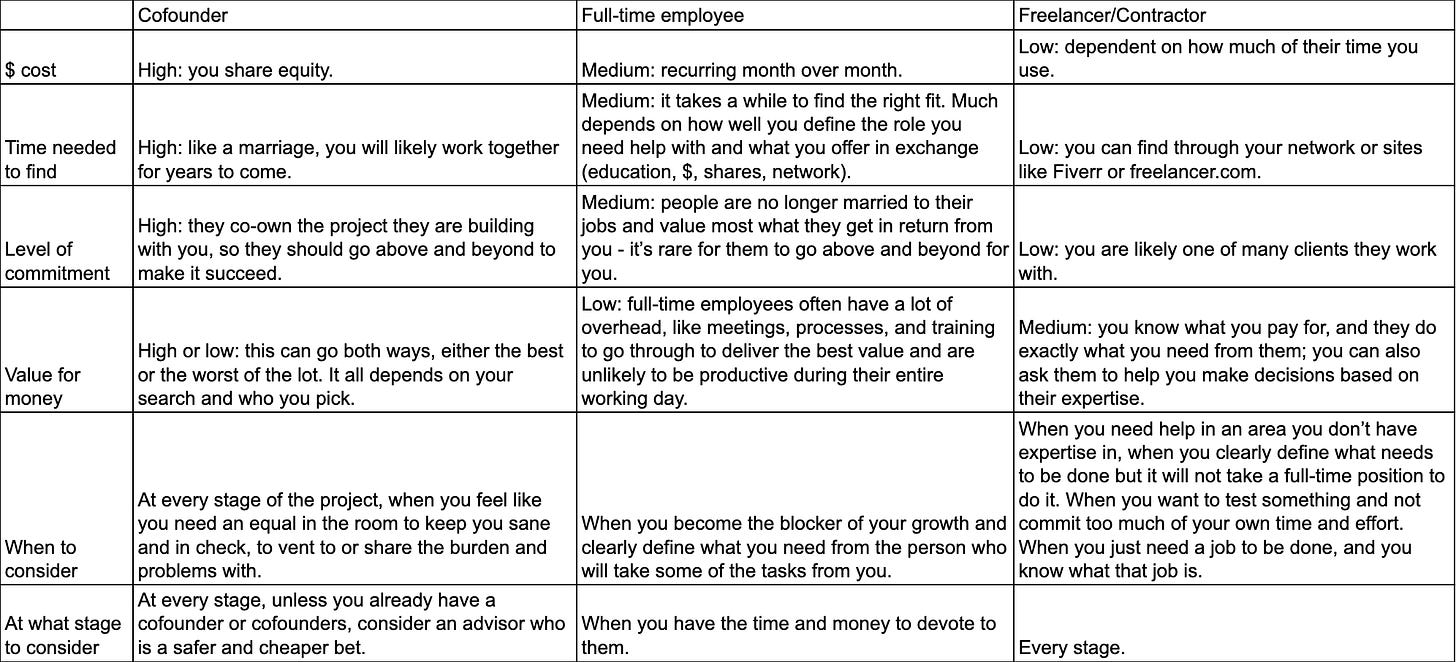Founders are the OG (yes, original growth) when it comes to growing their projects. They are the first ones on board and know the ins and outs better than anyone else. Their mission is to grow beyond zero MMR (monthly recurring revenue), users, signups, and reviews, which is the make-it-or-break-it for every company.
The times when funding rounds were easy to secure just on the prototype alone with no traction to show for it are over, unless you are in the Web3 and carry clout with your name. Therefore, as a founder, you have to focus specifically on "Making something people want" - a well-known motto at Y Combinator, one of the most renowned startup accelerators.
The founder must be the OG
The OG should come from the founder to validate your idea. Talk to people and show them what you have. The OG doesn’t just boil down to you being the founder but the person who can most effectively communicate the product’s value to potential users or investors. Even if you don’t have any marketing experience, you won’t be the only one in such a position. Mark Zuckerberg is a developer who was the OG of his social media platform. He was instrumental in driving its growth from the beginning by being Facebook’s biggest advocate.
Another example is Airbnb’s founders - Brian Chesky, Joe Gebbia, and Nathan Blecharczyk. They were responsible for both the conceptual work behind Airbnb. In fact, they offered their own apartments for rent during conferences in San Francisco to validate whether Airbnb was worth pursuing further. That hands-on approach helped them better understand their product-market fit (PMF).
A similar approach is what the Collison brothers did in YC in the early Stripe days. The goal is to easily explain what you do and how others will benefit from your product. If what you have doesn’t excite the people you are talking to, then consider whether you’re using the right language or talking to the right audience. I bet that if the Collison brothers talked to mom-and-pop stores that didn’t have any digital sales or focused on the in-depth technicalities of their solution, then they would not have gotten very far.
But they talked to tech people who understood the problem digital payments brought to the table and used simple language that everybody understood: you can start accepting online payments by inserting these three lines of code on your website. Then they created the account for you and showed you how easily you can implement Stripe on your site.
That was the aha moment right there. People were hooked—no more lengthy product setup, implementations, and configuration. Stripe went ahead and took out the most difficult part of the process and left only the essentials. They combined the two key elements of a solution that people needed with the ease of implementation that even a non-developer can complete.
The Collison brothers were Stripe’s OGs. And you have to be one for your project.
Validate your idea, build a minimum viable product (MVP) to get users to the aha moment, and promote it. You don’t need sophisticated growth expertise to do that the right way. You have the mission that brought you this far in this project that will show your enthusiasm and strengthen your message. Nobody will be able to sell the aha moment better than you.
OG founders must find the PMF
One of the main roles of an OG founder is to find a PMF. When a product has achieved a market fit, it has successfully addressed a problem or fulfilled a need in the market and found a receptive audience. It goes beyond having a good product or service; it signifies that the product is well-suited to the target market and customers are willing to pay for it. This is key to scaling your business/startup and an important prerequisite for sustainable growth.
One of the biggest mistakes I’ve seen founders make is avoiding finding a product-market fit by themselves. They outsource it to an agency, a freelancer, or an advisor or hire someone to do it in-house. Imagine having a kid and hiring someone to raise them and figure out what they want to do in life. Now imagine if the AirBnB founders hired someone else to work on their PMF. Do you think they’d last as long as they did with all their initial struggles?
The motivation, hindsight, and possibilities seen by an employee, freelancer, or agency are completely different from the founder’s perspective. In the past, there was the belief that "If you build it, they will come" (thanks, Field of Dreams), but the truth that’s been proven time and again with startups is that "If you achieve product-market fit, growth will come."
It’s the same as a founder missing the point of building a startup and then avoiding the work of finding out who it works best for and how to explain it to them. I might be biased here because I’m fascinated with how products work and the mechanics behind the product offering, value proposition, language used to describe it, and how the prospect perceives them. That’s the holy grail of finding a product-market fit and traction - getting the combination of these elements in the right order to crack open the safe and reach paying users.
PMF is very difficult to find and keep, but this is one of the first steps that makes or breaks a startup. You either have it or don’t. There is no 30% or 70% PMF. The market either understands and wants what you have to offer, or they don’t. There are a million different reasons why they will go either way, and it’s your job as the founder to understand many of those reasons and navigate your startup to acquire users. Even when you have it, it doesn’t mean you’ll have it forever. You must keep up with the changing market landscape, societal changes, and expectations to maintain your users and acquire new ones.
Another important indicator of PMF is negative churn - increased revenue from existing customers through expansions, cross-sells, and upsells. If you are losing customers, but the negative churn outpaces your churn, then you know you have PMF and a better understanding of which segment is your target persona.
Remember Odeo? They were a podcast platform until Apple came along and introduced podcasts on iTunes. Odeo quickly lost relevance and had to pivot. And that’s how they became what we know now as Twitter. PMF is not static. It evolves.
What happens next?
Once you reach the PMF, the focus needs to move on to scaling your operations and meeting increasing demand. If you’re alone when the time comes to tending to existing users and acquiring new ones, then you just signed up for a new job with the same bandwidth as before. This is the moment you need to prepare for. You need to know who to hire and plan what that process will look like in advance. Will you need a marketer? A customer support rep? An account manager? Or someone else entirely? But since you already did those jobs and planned in advance, you’ll be ready to start hiring when it’s clear that the scaling has begun. You will only unlock further growth by ensuring the user experience before and after the transaction is to the users’ liking.
Think about what Uber did in San Francisco - their original market. They focused on cultivating that market and hired to scale beyond San Francisco. The team that got you here won’t get you to the worldwide domination that Uber has achieved, so they had to scale and repeat their model in the next city.
After achieving PMF, Dropbox scaled rapidly thanks to a referral program where users got extra storage space for referring friends. Again, the skillset of building the framework for how you achieved PMF is different than the one required to scale.
Being hands-on with finding your PMF will give you so much context that’s vital to how your startup should move forward that it would be foolish to throw away this opportunity. You must see firsthand how users react, perceive, and use your product. This way you’ll be able to figure out how you can change your approach through messaging, design, audience, channels, or features - giving you the perfect understanding of who you need on your team to help succeed.
Who can help you find your PMF?
Sometimes, even an OG founder can have issues finding a PMF, or the process should be sped up due to market or financial circumstances. Who should a founder reach out to, and why?
Imagine you’re nowhere close to your PMF and hear you should hire a marketer. Great, but who exactly do you want to hire? According to Masterclass, there are 15 kinds of marketing jobs. How will you know which one you need to fit that position best? Do you need a specialist to focus on one field or a Swiss Army knife marketer who will do everything? These are two completely different recruitment processes you’d have to work on.
Maybe the people who assessed the need and decided they need a marketer are wrong, and you really need a product manager? Then once you hire that person after a lengthy process of finding and interviewing candidates, you have to onboard and set goals for the new employee. This commitment will require your attention, time, and money. All that can be wasted if they leave or you fire them after a month or two, and you are back to square one.
You can avoid a lot of miscommunication and potential problems by being involved in finding the PMF first-hand. You’ll be able to hire the right people you need, talk to investors, and mention the findings and problems you’re encountering in the trenches, manage and set the direction for your teams, and decide on a product roadmap.
It’s not easy, but the long-term benefits outweigh the costs by a mile. So you will need to think about all these things as you move forward, so you should consider not doing it alone.
Do you need a cofounder?
Like the old saying, “If you want to go fast, go alone, but if you want to go far, go together,” sharing your ideas, difficulties, and stress with someone as invested in the project as you is a great help.
Personally, I don’t know if we’d go through with our business as a growth marketing agency if we didn’t have each other. There is a tradeoff, equity for more comfort and speed, but it’s better to own 1% of Airbnb than 100% of a failed startup at the end of the day.
Do you need support?
Cofounders are not for everyone, but you may still want to find help.
Investing in a full-time employee who can be your day-to-day support or a freelancer might be best. Having done the latter numerous times myself, I prefer to approach such situations by briefing what I expect of them and how it should be done. They do it to save time, and we’re both happy. Low overhead, decent cost, and you get what you expect - more work done in the same amount of time.
How do you decide which is right for you?
Now that I’ve laid out these three options, it’s time to ask yourself which would be best for you. Do you want an equal cofounder to share the responsibilities and inevitable stress? Do you want a full-time employee to delegate day-to-day tasks to? Do you want a freelancer to help carry the load?
To help you decide, we prepared a table with the pros and cons for each solution:
Wrapping up
Obviously, as in life, there are many different ways to achieve your goals, as each founder’s path to success poses its own unique challenges and obstacles. However, the patterns we discussed are a standard part of the entrepreneurial journey and will affect every OG founder sooner or later.
We wish every founder to find the PMF quickly, build a real growth team, and scale up the business, which we’ll discuss in future articles. ✌️






